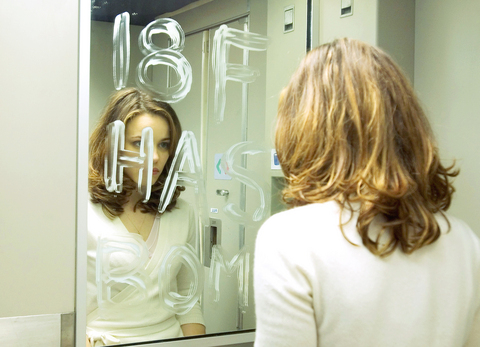In Red Eye, a nifty, tense thriller directed by Wes Craven, the young actress Rachel McAdams plays the world's greatest hotel worker. Even Russell Crowe would be hard-pressed to misbehave under the gentle watch of McAdams' charmer, an amalgam of smiles and steel named Lisa Reisert, who greets every problem -- cranky hotel guests and terrorists alike -- with can-do spirit. If you don't like your hotel room, Lisa will move you to nicer accommodations. And if you're planning to take out a deputy secretary of homeland security, well, Lisa will take care of you, too.
In Wes Craven's Red Eye, McAdams is a hotel worker who learns that the man in the next seat, played by Cillian Murphy, is a
terrorist.

PHOTO: REUTERS
Written by Carl Ellsworth from a story by Ellsworth and Dan Foos, Red Eye brings together a classic thriller setup (a damsel in distress) and a relevant-sounding if thoroughly undercooked story involving worldwide terrorism. Despite a half-dozen actors made up to look like secret service agents and a big bang that ends the show, the real action in Red Eye unfolds in the close confines of an airborne passenger plane.
When Lisa, en route home to Miami after attending a funeral, settles into steerage, she has no clue that a crying baby will be the least of her worries, what with the turbulence at takeoff and her very own personal terrorist, Jackson (Cillian Murphy), parked in the next seat.
Lisa first meets Jackson while standing in the check-in line. Hard-wired to help, Lisa has just gently berated a rude passenger on behalf of a harried airline worker, only to receive a mouthful of boorish attitude in return. Jackson, who had been hovering behind her, comes to Lisa's defense, forming a tentative bond that will be strengthened when they have a drink in the airport bar. Later, the two will also be seated in their own row on the plane, an apparent coincidence that pleases Lisa, deepening the rosy flush in her cheeks. After Jackson talks Lisa through their bumpy takeoff, she asks him what he does for a living. Oh, he says, turning his icy blues on her, "government overthrow, high-profile assassinations," you know, the usual.
It would give away too much of the film's skeletal plot to explain why Lisa has attracted such lethal company. Suffice it to say that Lisa's father, Joe (Brian Cox), plays a part in the larger picture, as does the deputy secretary of homeland security (Jack Scalia) and a rabbity hotel clerk (Jayma Mays). Mostly, though, the focus remains on Lisa and Jackson, who to outward appearances look like any other traveling young couple.
Craven, a horror veteran who has a long history of infusing seemingly ordinary situations with a palpable sense of dread (think of Drew Barrymore simply on the phone in the opening of Scream), turns the sights and sounds of two people talking into a nerve-jangling duet for cat and mouse, hunter and prey.
Murphy, who plays a Renfield-like character with appreciable wit in Batman Begins, makes enough of a picture-perfect villain here that his agent should worry about typecasting. The actor may not be remotely believable as a man of international mystery, but those baby blues look cold enough to freeze water and his wolfish leer suggests its own terrors.
Red Eye is rated "parents strongly cautioned." The film contains violence courtesy of a pen, a stiletto heel, a large knife, a larger truck and guns.

One of the biggest sore spots in Taiwan’s historical friendship with the US came in 1979 when US president Jimmy Carter broke off formal diplomatic relations with Taiwan’s Republic of China (ROC) government so that the US could establish relations with the People’s Republic of China (PRC). Taiwan’s derecognition came purely at China’s insistence, and the US took the deal. Retired American diplomat John Tkacik, who for almost decade surrounding that schism, from 1974 to 1982, worked in embassies in Taipei and Beijing and at the Taiwan Desk in Washington DC, recently argued in the Taipei Times that “President Carter’s derecognition

This year will go down in the history books. Taiwan faces enormous turmoil and uncertainty in the coming months. Which political parties are in a good position to handle big changes? All of the main parties are beset with challenges. Taking stock, this column examined the Taiwan People’s Party (TPP) (“Huang Kuo-chang’s choking the life out of the TPP,” May 28, page 12), the Democratic Progressive Party (DPP) (“Challenges amid choppy waters for the DPP,” June 14, page 12) and the Chinese Nationalist Party (KMT) (“KMT struggles to seize opportunities as ‘interesting times’ loom,” June 20, page 11). Times like these can

JUNE 30 to JULY 6 After being routed by the Japanese in the bloody battle of Baguashan (八卦山), Hsu Hsiang (徐驤) and a handful of surviving Hakka fighters sped toward Tainan. There, he would meet with Liu Yung-fu (劉永福), leader of the Black Flag Army who had assumed control of the resisting Republic of Formosa after its president and vice-president fled to China. Hsu, who had been fighting non-stop for over two months from Taoyuan to Changhua, was reportedly injured and exhausted. As the story goes, Liu advised that Hsu take shelter in China to recover and regroup, but Hsu steadfastly

You can tell a lot about a generation from the contents of their cool box: nowadays the barbecue ice bucket is likely to be filled with hard seltzers, non-alcoholic beers and fluorescent BuzzBallz — a particular favorite among Gen Z. Two decades ago, it was WKD, Bacardi Breezers and the odd Smirnoff Ice bobbing in a puddle of melted ice. And while nostalgia may have brought back some alcopops, the new wave of ready-to-drink (RTD) options look and taste noticeably different. It is not just the drinks that have changed, but drinking habits too, driven in part by more health-conscious consumers and